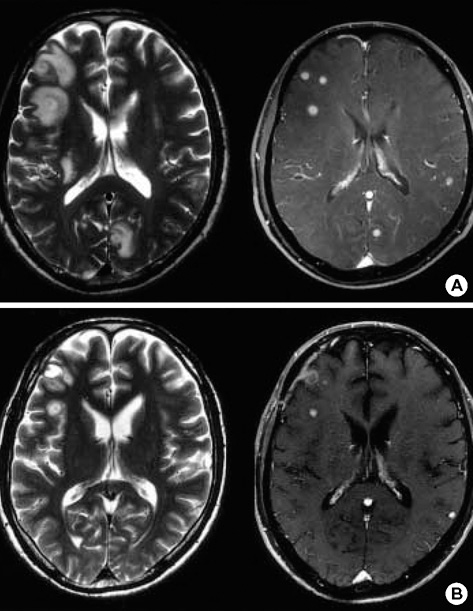J Korean Med Sci.
2007 Sep;22(Suppl):S171-S173. 10.3346/jkms.2007.22.S.S171.
Multiple Intracranial Tuberculomas Mimicking Granulocytic Sarcomas in Acute Myeloid Leukemia
- Affiliations
-
- 1Department of Internal Medicine, Chonnam National University Medical School, Gwangju, Korea. hjoonk@chonnam.ac.kr
- 2Department of Neurosurgery, Chonnam National University Medical School, Gwangju, Korea.
- KMID: 1785810
- DOI: http://doi.org/10.3346/jkms.2007.22.S.S171
Abstract
- The diagnosis of incracranial tuberculoma in immune-compromised hosts is often difficult because conventional magnetic resonance (MR) imaging of tuberculoma reveals various findings and neurologic symptoms are not typical. Here, we report a case of a 54-yr old man with multiple intracranial tuberculoma who was treated for acute myeloid leukemia. He complained of right-side paresthesia after the third consolidation chemotherapy without leukemic relapse and fever. MR imaging of the brain showed multiple ring-enhanced lesions in the cerebrum, cerebellar hemisphere, and pons. The lesions appeared to mimic a metastatic tumor or abscess. Cerebrospinal fluid analysis showed no abnormal cells, but the level of adenosine deaminase was elevated (28.8 IU/L, normal 0-8). Stereotactic brain biopsy was performed, but only reactive gliosis was observed. To confirm diagnosis, an open brain biopsy was performed. The histopathology demonstrated chronic granulomatous inflammation with caseous necrosis. Tuberculous-polymerase chain reaction of the biopsy showed a positive result. He was treated with anti-tuberculosis medication and a high dose of steroid. Paresthesia improved, and follow-up brain MR imaging showed the decreased size and numbers of ring-enhanced lesions and improvement of perilesional edema 1 month after treatment. Here, we report on an interesting case of intracranial tuberculoma in acute myeloid leukemia.
MeSH Terms
Figure
Reference
-
1. Park SP, Choi JH, Doh JO. Clinical analysis of intracranial tuberculomas. J Korean Neurosurg Soc. 1984. 13:425–431.2. Dastur DK, Manghani DK, Udani PM. Pathology and pathogenetic mechanisms in neurotuberculosis. Radiol Clin North Am. 1995. 33:733–752.3. Tsugawa J, Inoue H, Tsuboi Y, Takano K, Utsunomiya H, Yamada T. Serial MRI findings of intracranial tuberculomas: a case report and review of the literature. No To Shinkei. 2006. 58:225–230.4. Chi-Shing Z, John LG, Paul K, Hervey DS, Jamshid A. Haaga JL, Lanzieri CF, Gilkeson RC, editors. Cerebral infections and inflammation. CT and MR imaging of the whole body. 2002. Vol(1):4th. Cleveland, USA: Mosby;220–224.5. Kim CY, Kim DG. Central nervous system tuberculoma. J Korean Neurosurg Soc. 1998. 27:21–28.6. Jagarlamudi R, Kumar L, Kochupillai V, Kapil A, Banerjee U, Thulkar S. Infections in acute leukemia: an analysis of 240 febrile episodes. Med Oncol. 2000. 17:111–116.
Article7. Guzel A, Tatli M, Aluclu U, Yalcin K. Intracranial multiple tuberculomas: 2 unusual cases. Surg Neurol. 2005. 64:Suppl 2. S109–S112.
Article8. Klossek A, Dannenberg C, Feuerhahn MR, Korholz D. Pulmonary tuberculosis in a child receiving intensive chemotherapy for acute myeloblastic leukemia. J Pediatr Hematol Oncol. 2004. 26:64–67.
Article9. Ku SC, Tang JL, Hsueh PR, Luh KT, Yu CJ, Yang PC. Pulmonary tuberculosis in allogeneic hematopoietic stem cell transplantation. Bone Marrow Transplant. 2001. 27:1293–1297.
Article10. Bayindir C, Mete O, Bilgic B. Retrospective study of 23 pathologically proven cases of central nervous system tuberculomas. Clin Neurol Neurosurg. 2006. 108:353–357.11. Farrell VJ. Brain stem tuberculoma in adult patients: diagnosis and treatment. Surg Neurol. 1990. 34:383–389.
Article12. O'Brien NC, van Eys J, Baram TZ, Starke JR. Intracranial tuberculoma in children: a new look at an old problem. South Med J. 1988. 81:1239–1244.13. Obara H, Nishimura S, Hayashi N, Numagami Y, Inoue T, Kubo K, Kaimori M, Nishijima M. Intracranial granulocytic sarcoma in a patient with acute myeloid leukemia. No To Shinkei. 2006. 58:797–801.14. Tatsui CE, Koerbel A, Prevedello DM, Araujo JC, Ditzel LF, Bleggi-Torres LF. Central nervous system granulocytic sarcoma after bone marrow transplant: case report. Arq Neuropsiquiatr. 2002. 60:852–855.15. Weiser MA, O'Brien S, Escalante C, Manzullo E. Tuberculosis meningitis in a patient with acute myelogenous leukemia. Leuk Lymphoma. 1999. 33:187–192.
- Full Text Links
- Actions
-
Cited
- CITED
-
- Close
- Share
- Similar articles
-
- Multiple Granulocytic Sarcomas in a Patient with Longstanding Complete Remission of Acute Myelogenous Leukemia
- Granulocytic Sarcoma in the Leg Mimicking Hemorrhagic Abscess
- Isolated Recurrence of Intracranial Granulocytic Sarcoma Mimicking a Falx Meningioma in Acute Myeloblastic Leukemia
- Meningeal Chloromain in Acute Lymphoblastic Leukemia
- A case of granulocytic sarcoma of the pancreas and kidney in a patient presenting with jaundice



